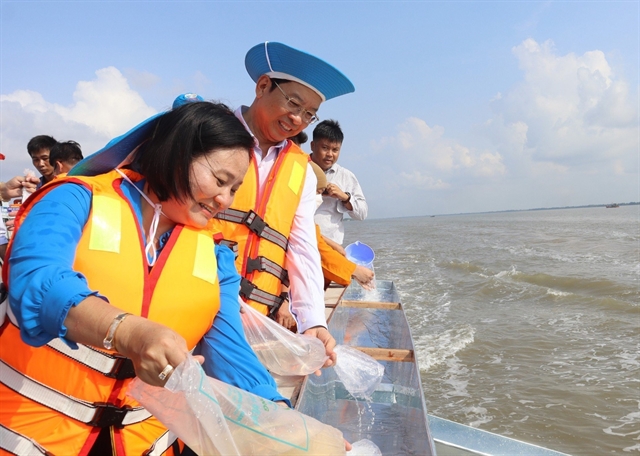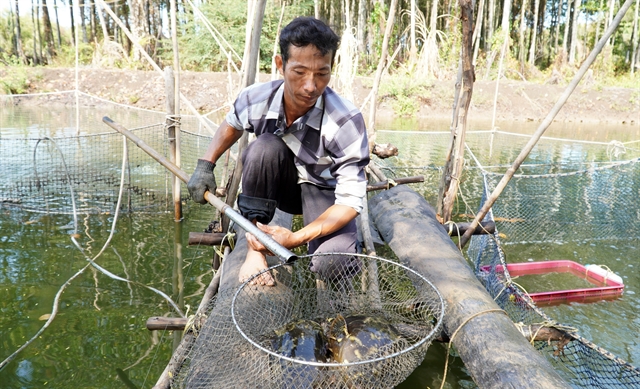 Society
Society

 |
| Caption: Farmer Trần Duy Khanh breeds grouper fish and other aquatic species in his mangrove forest in Hòn Đất District’s Lình Huỳnh Commune in Kiên Giang Province. – VNA/VNS Photo Văn Sĩ |
HCM CITY – Breeding shrimp and other aquatic species in mangrove forests in the Cửu Long (Mekong) Delta both offers a steady income to households protecting forests and improves conservation.
The delta, which comprises 12 provinces and Cần Thơ City, has more than 73,000ha of mangrove forests, or 51 per cent of the country’s total.
Coastal provinces such as Cà Mau, Bạc Liêu, Sóc Tăng, Kiên Giang, and Bến Tre have large forest areas where shrimp is farmed.
In Kiên Giang, mangrove forests play an important role in protecting sea dykes and preventing erosion, and the allocation of these forests to local households to protect and breed aquatic species in them has helped thousands escape poverty.
Danh Trung, an ethnic Khmer in Hòn Đất District’s Thổ Sơn Commune, said his family used to be a poor before local authorities allocated three hectares of mangrove forests in 2013.
For the first three years, his family only caught what shrimp and fish there were and earned VNĐ30-50 million (US$1,200 - 2,000) a year.
After learning some farming, he began to buy shrimp and crab to breed in the forest in 2016.
His family now harvests more than one tonne of shrimp, crab and fish a year and earns VNĐ100 million ($4,000), he said.
“My family has escaped poverty and can pay fees for two children to go to school.”
Most forest-protection households in the province used to survive on catching fish and other aquatic species in the wild before they were allotted forests.
By then, their catches had also dwindled and life had become difficult.
Lê Văn Giàu, head of the Hòn Đất Bureau of Agriculture and Rural Development, said in three communes in the district, Thổ Sơn, Lình Huỳnh and Bình Sơn, the breeding of black-tiger shrimp, white-legged shrimp, mud crab, and blood cockle in mangrove forests has developed rapidly.
Aquatic species farmed in mangrove forests are bred to biosafety standards without industrial foods and chemicals, and so taste better than those bred using industrial or semi-industrial methods, he said.
The district would co-operate with relevant government agencies and companies to expand the breeding of aquatic species to Vietnamese good agricultural practices standards to improve their value and farmers’ incomes, he said.
It has about 6,500ha of mangrove forests.
In Trà Vinh Province, thousands of households in coastal areas are carrying on aquatic species - forestry farming in 8,000ha of mangrove forests and earn an average of VNĐ150 million ($6,000) per hectare a year.
Its lucrative nature has made more farmers participate in growing new mangrove forests, helping increase the province’s forest cover.
Trần Trường Giang, director of the Trà Vinh Department of Agriculture and Rural Development, said the province encourages farmers in coastal areas to expand farming of aquatic species in forests to cope with climate change.
It has zoned more than 23,980ha in coastal areas to develop the model.
It financially assists farmers by subsidising seedling costs by 50 per cent.
Sustainable development
Authorities in the delta have allocated more mangrove forests to households to protect and exploit their resources.
These households can use up to 30 per cent area of the forest land to breed shrimp and other aquatic species.
Kiên Giang has allocated forests to more than 1,900 households since 2011, according to its Department of Agriculture and Rural Development.
Lê Hữu Toàn, its director, said the management of forests has been effective and illegal logging has reduced.
“To develop the models, the province focuses on getting farmers to participate in co-operative groups and co-operatives which have linkages [with companies] to secure outlets.”
The province implements programmes and projects that help farmers access advanced techniques for breeding aquatic species in combination with offering tourism services, he said.
The department instructs its agencies to inspect the environment, water resources and the breeding creatures to ensure productivity, he said.
In Cà Mau Province, there are 40,500ha of shrimp - forest farming, the country’s largest area, according to its Department of Agriculture and Rural Development.
Most of these forests are situated in Năm Căn and Ngọc Hiển districts.
To develop the model, at the beginning of this year the province introduced it in Năm Căn District’s Lâm Hải Commune, where 700 households have been allotted 2,500ha of mangrove. – VNS




